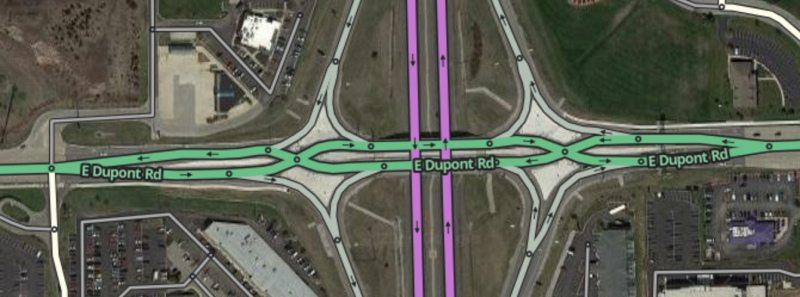Diverging Diamond Interchange (DDI)
See also: Diverging Diamond Interchange article on Wikipedia.
Diverging diamond interchanges (DDI) are a type of diamond interchange in which the two directions of traffic cross to the opposite side as they pass over/under the limited-access roadway.
This type of interchange is unusual, in that it requires traffic to briefly drive on the opposite side of the road from what is customary for the jurisdiction.
At-Grade Intersections
(TODO: add zoomed in pic of one of the at-grade intersections)
All DDI's contain exactly 12 at-grade intersections:
- Two "outer surface road" intersections, where drivers on the surface road enter/exit the DDI
- Two "inner surface road" intersections, where the two directions of travel along the surface road "cross over" each other at signaled intersections.
- Four "offramp" intersections, where drivers use ramps to exit the limited-access road and enter the DDI
- Four "onramp" intersections, where drivers transition from the surface road segments inside the DDI onto ramps that lead to the limited-access road
Junctions
All 12 interchanges are modeled with a junction point in the Waze map.
Turn Restrictions
Summary:
- ALL turns less than 90 degrees are enabled
- ALL turns greater than or equal to 90 degrees are disabled
Exactly six turns are disabled in a DDI:
Outer Surface Road Intersections:
(TODO: add zoomed in pic of the disabled turn at an outer surface road intersection, with the segment in question highlighted)
Disable the SINGLE turn from the one-way segment carrying traffic exiting the DDI to the one-way segment carrying traffic entering the DDI at both outer surface road intersections, for a total of two disabled turns.
Inner Surface Road Intersections:
(TODO: add set of zoomed in pics for the disabled turns at an outer surface road intersection, one pic per segment with diabled turns)
Disable the TWO turns from one-way segments to the segments carrying traffic the opposite direction at both inner surface road intersections, for a total of four disabled turns.
